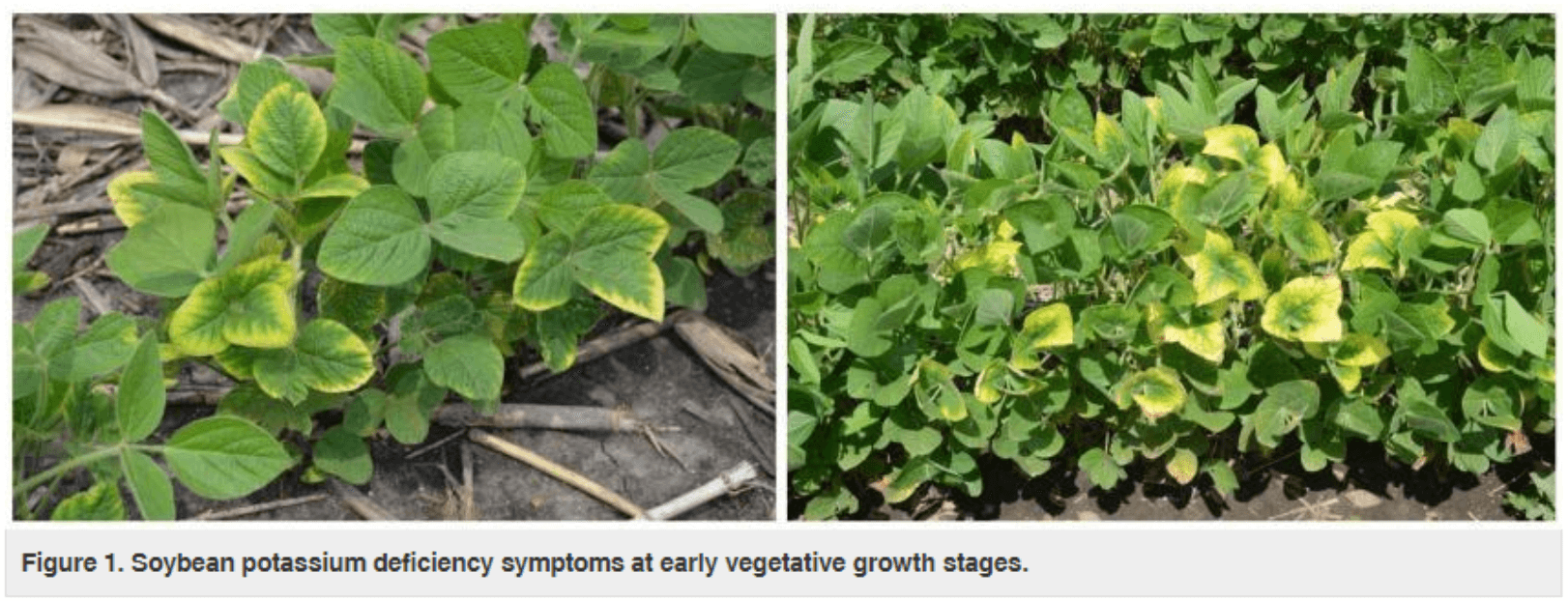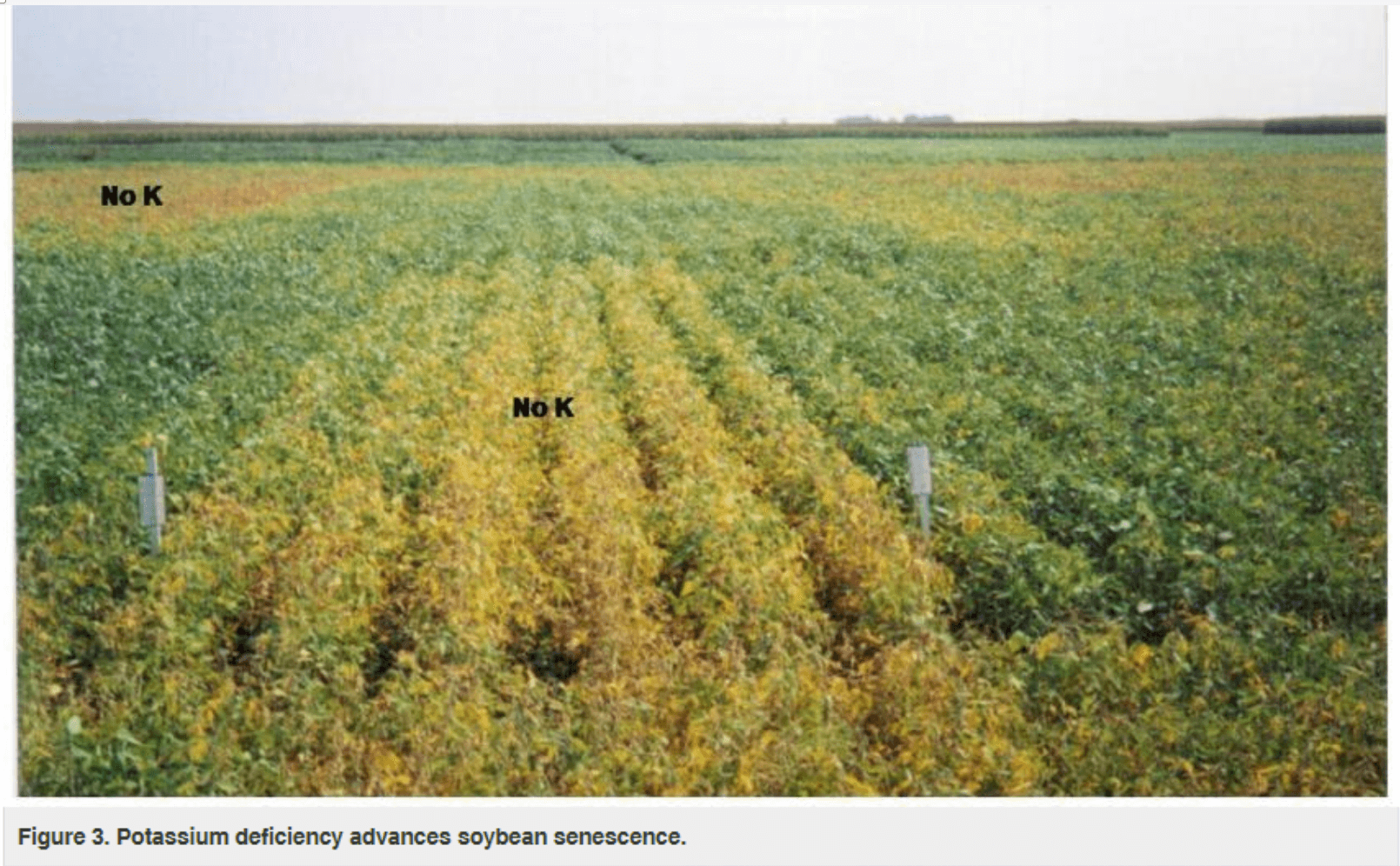Brought to you by: Jonah T. Johnson, MS, CPAg, CCA - Sales Agronomist, PCT | Sunrise
August 26, 2019: Upper-canopy, late-season potassium (K) deficiency showing in soybeans
Every year in August, soybeans are susceptible to nutrient deficiencies, some documented (i.e. soil & tissue test analysis report low K values that did not receive adequate preplant K fertilization) and some are environmentally induced. Nutrients like potassium (K) and manganese (Mn) need water to be “in-solution” for plant root availability. Typically, K deficiency shows up in the lower to middle canopy with yellowing beginning at the leaf edges and moves its way towards the middle of the leaf. Severe K deficiency can cause a scorched look with plant dieback.
The last several years we have observed more and more soybean plants exhibiting K deficiency in the middle to upper canopy in Ohio, which is counter intuitive to normal K deficiency progression. Potassium is a mobile nutrient within the plant, and physiologically the plant will translocate K from older leaves through the plant xylem into the newest growth to satisfy the new leaves’ demand. The exact reason we are seeing more K deficiency in the upper canopy is not well understood, but one suspicion is that higher yielding plants create a higher demand for K-fertilization during late seed-fill, causing premature plant cannibalization.
The following article excerpt is by Dr. Antonio Mallarino, Professor of Soil Fertility and Nutrient Management and Extension Specialist at Iowa State University, that addresses more on this issue:
Due to poorly understood reasons, K deficiency symptoms in upper soybean leaves also have become common at middle to late reproductive stages. Moreover, K deficiency symptoms can develop in upper leaves in well-fertilized soybean when no deficiency was observed at early stages, mainly when drought conditions develop during late spring or summer.
In low-testing or draughty soils, K deficiency symptoms may develop from the V3 stage to more advanced vegetative stages mainly in the older leaves, but with severe deficiency, symptoms may progress to the upper leaves. Figure 1 shows typical soybean K deficiency symptoms at early growth stages. The symptom is yellowing of the leaflet margins with mild deficiency that becomes brown or necrotic with extreme deficiency. The symptoms of these leaves often remain until the reproductive stages but may not be seen because the leaves have been shed or partially decomposed. The reason symptoms are observed mainly on older leaves at early vegetative growth stages is because K is very mobile within the plant and K is translocated from older leaves to new leaves.

The K deficiency symptoms in soybean during middle to late reproductive stages are similar to those observed earlier in the season on older leaves. Figure 2 shows typical examples. The physiological reasons for late-season development of deficiency symptoms during the last couple of decades are not entirely clear. Reasons might be that with increasing soybean yield potential there is more K translocation from the middle or upper leaves to developing pods and grain.

Observations over many years have shown that severe K deficiency can advance soybean maturation. Therefore, it is not surprising to see senescing soybean, with most leaves yellow or brown, in low-testing field areas a few days before plants in other parts of a field. Figure 3 shows an example of this in research plots. Keep in mind that deficiency of other nutrients or conditions such as excessively wet or dry soil can also advance soybean senescence.

Several soybean diseases can also produce yellowing of upper leaves, which also may advance senescence. Sometimes, the disease symptoms and K deficiency symptoms occur at the same time. This is not surprising because Iowa research has demonstrated that K deficiency aggravates the incidence or severity of several soybean leaf diseases. Additional field observations suggest possible interactions with soybean cyst nematode (SCN) and aphid infestation levels. Potassium deficiency symptoms in soybean can develop or be worse in field areas associated with SCN or aphids.